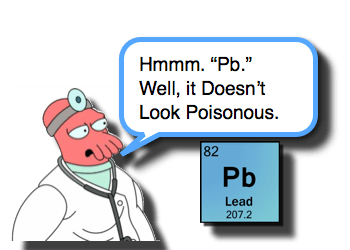Lead Poisoning
Poisonings certainly get practitioners’ attention; but some may present in a very subtle manner, making our task quite challenging. Lead Poisoning does not often present with acute symptoms either, making it even more difficult to think of, but it is another great example of our opportunity to utilize our clinical skills to help benefit a child. To ensure that we don’t disregard the patient with Chronic Recurrent Abdominal Pain so quickly or overlook the significance of Pica, let us review Lead Poisoning.
Lead Poisoning: Scary Numbers
- Lead is a ubiquitous heavy metal, but should not exist in our bodies.
- Lead Poisoning effects all populations of the world, particularly industrialized regions.
- While the prevalence of lead poisoning has declined, it still remains extraordinarily high, despite significant efforts.
- ~4 million households have elevated environmental lead levels, increasing lead exposure. [CDC-Lead]
- ~500,000 U.S. children (1-5 years of age) have elevated blood lead levels. [Meyer, 2003]
Lead Poisoning: Kids are at Greater Risk
- Toddlers and infants are closer to the ground and, therefore, easily ingest settled lead dust.
- Toddlers and infants like to put things in the mouths.
- Children with behavioral / mental issues may also have Pica, which can even lead to acute toxicities. [George, 2010]
- Children absorb more lead through their GI tract than adults.
- Lead can cross the child’s immature blood-brain barrier more easily than adults.
Lead Poisoning: Common Sources of Lead
- Lead-based paints still exist in older homes
- Toys that are not regulated
- Other objects that are ingested (ex, bullets, pellets, fishing weights, jewelry)
- Folk remedies
- Cosmetics
- Exposure from family member’s occupation (ex, Miner, Jeweler, Plumber)
- Drinking water (ex, Flint, Michigan)
Lead Poisoning: Presentation
- Ranges from asymptomatic to non-specific symptoms to overt encephalopathy and seizures.
- Lead poisoning affects multiple systems, including GI, Heme, Renal, and Neuro.
- GI Toxicitiy
- Nausea, vomiting
- Abdominal pain / colic
- Constipation
- Heme Toxicity
- Lead interferes with heme production.
- Creates a microcytic anemia, with basophilic stippling
- Often seen concurrently with iron deficiency (GI transporters will more avidly uptake heavy metals in this situation).
- Renal Toxicity
- Acquired Fanconi Syndrome – dysfunction of the proximal tubular cells
- High uric acid levels and subsequent gouty arthritis
- Neuro Toxicity
- Irritability, headaches (can be misconstrued as being due to a “viral illness”).
- Confusion
- Tremors, seizures
- Encephalopathy
- Chronic exposure is known to adversely effect IQ and behavioral development.
- Can cause peripheral motor neuropathy (i.e., wrist drop). [Dsouza, 2009]
- GI Toxicitiy
Lead Poisoning: The Lead Level
- There is no “safe” lead level – we are not supposed to have lead in our bodies.
- Much of the treatment of elevated lead, though, focuses on identifying the exposure and eliminating it.
- Chelation is not generally recommended until levels are > 44 mpg/dL.
- Succimer (DMSA) – can cause rash and liver injury
- Calcium EDTA – can cause kidney injury
- Dimercaprol (BAL) – Painful IM injections, can cause sterile abscesses
Lead Poisoning: Questions to Consider
- If you antennae have detected the possibility of lead poisoning as the cause of your patient’s vague / mysterious complaints, consider these questions which may help enhance your diagnostic certainty.
- Any family members (siblings) with known elevated Blood Lead Levels?
- Prolonged exposure to house/buildings built before 1978?
- Live near factory where lead is used?
- Live with a family member who’s occupation/hobby exposes him/her to lead?
- Adoptee or refugee from country with known lead exposures?
References
Creighton S1, Hafner JW, Aldag JC. Effectiveness of a pediatric verbal lead exposure screening protocol in emergency department patients. Pediatr Emerg Care. 2013 Feb;29(2):156-61. PMID: 23364376. [PubMed] [Read by QxMD]
George M1, Heeney MM, Woolf AD. Encephalopathy from lead poisoning masquerading as a flu-like syndrome in an autistic child. Pediatr Emerg Care. 2010 May;26(5):370-3. PMID: 20453792. [PubMed] [Read by QxMD]
Dsouza HS1, Dsouza SA, Menezes G, Thuppil V. Evaluation and treatment of wrist drop in a patient due to lead poisoning: case report. Ind Health. 2009 Dec;47(6):677-80. PMID: 19996545. [PubMed] [Read by QxMD]
Meyer PA1, Pivetz T, Dignam TA, Homa DM, Schoonover J, Brody D; Centers for Disease Control and Prevention. Surveillance for elevated blood lead levels among children–United States, 1997-2001. MMWR Surveill Summ. 2003 Sep 12;52(10):1-21. PMID: 14532866. [PubMed] [Read by QxMD]
Counter SA1. Brainstem neural conduction biomarkers in lead-exposed children of Andean lead-glaze workers. J Occup Environ Med. 2002 Sep;44(9):855-64. PMID: 12227678. [PubMed] [Read by QxMD]



[…] Pediatric EM Morsels: Lead Poisoning http://pedemmorsels.com/lead-poisoning/ […]